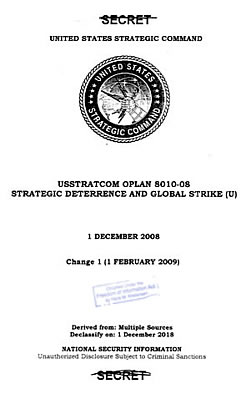Rewriting US Presidential Nuclear War Planning Guidance
 |
| How will Obama reduce the role of nuclear weapons in the strategic war plan? |
.
By Hans M. Kristensen
The Obama administration has begun a review of the president’s guidance to the military for how they should plan for the use of nuclear weapons. The review, which was first described in public by National Security Advisor Tom Donilon, is the ultimate test of President Obama’s nuclear policy; the rest is just words: to what extent will the new guidance reduce the role of nuclear weapons in the war plan?
Although the administration’s Nuclear Posture Review is widely said to reduce the role of nuclear weapons, it doesn’t actually reduce the role that nuclear weapons have today because all the adversaries in the current strategic nuclear war plan are exempt from the reduction. They are either nuclear weapon states, not members of the nuclear Non-Proliferation Treaty, or are in violation of their NPT obligations and have chemical or biological weapons. The new guidance would have to remove some of these adversaries from the war plan to reduce the role, or reduce the role that nuclear weapons are required to play against each of them. There are many ways this could be done:
- Reduce the numer of target categories that are held at risk with nuclear weapons.
- Reduce the damage expectancy to be a achieved against individual targets.
- Reduce the number of adversaries in the plan.
- Reduce the number and types of strike options against each adversary.
- Remove the requirement to plan for prompt launch of nuclear forces.
- Remove any requirement to plan for damage limitation strikes.
- End counterforce nuclear planning.
- End the requirement to maintain standing fully operational strike plans.
Reducing the role of nuclear weapons in the war plan requires direct and continuous presidential attention to avoid that the commitments to reducing the number and role of nuclear weapons are watered down by bureaucrats and cold warriors in the National Security Council, Department of Defense, military commands and Services, as well as former officials who are busy lobbying against a reduction.
To support president Obama’s vision of dramatically reduced nuclear arsenals and a reduced role of nuclear weapons on the way to deep cuts of nuclear weapons and eventually disarmament, we published a study in 2009 that proposed a transition from counterforce planning to what we called a minimal deterrent. A study from 2010 further described the current strategic nuclear war plan (OPLAN 8010-08 Change 1 from February 1, 2009 – this plan is still in effect). Building on those two studies, we have a new op-ed in the Bulletin of the Atomic Scientists that describes what a new presidential directive could look like: A Presidential Policy Directive for a new nuclear path.
This publication was made possible by a grant from Carnegie Corporation of New York and Ploughshares Fund. The statements made and views expressed are solely the responsibility of the author.
Satellite imagery has long served as a tool for observing on-the-ground activity worldwide, and offers especially valuable insights into the operation, development, and physical features related to nuclear technology.
This report outlines a framework relying on “Cooperative Technical Means” for effective arms control verification based on remote sensing, avoiding on-site inspections but maintaining a level of transparency that allows for immediate detection of changes in nuclear posture or a significant build-up above agreed limits.
The grant comes from the Carnegie Corporation of New York (CCNY) to investigate, alongside The British American Security Information Council (BASIC), the associated impact on nuclear stability.
Satellite imagery of RAF Lakenheath reveals new construction of a security perimeter around ten protective aircraft shelters in the designated nuclear area, the latest measure in a series of upgrades as the base prepares for the ability to store U.S. nuclear weapons.